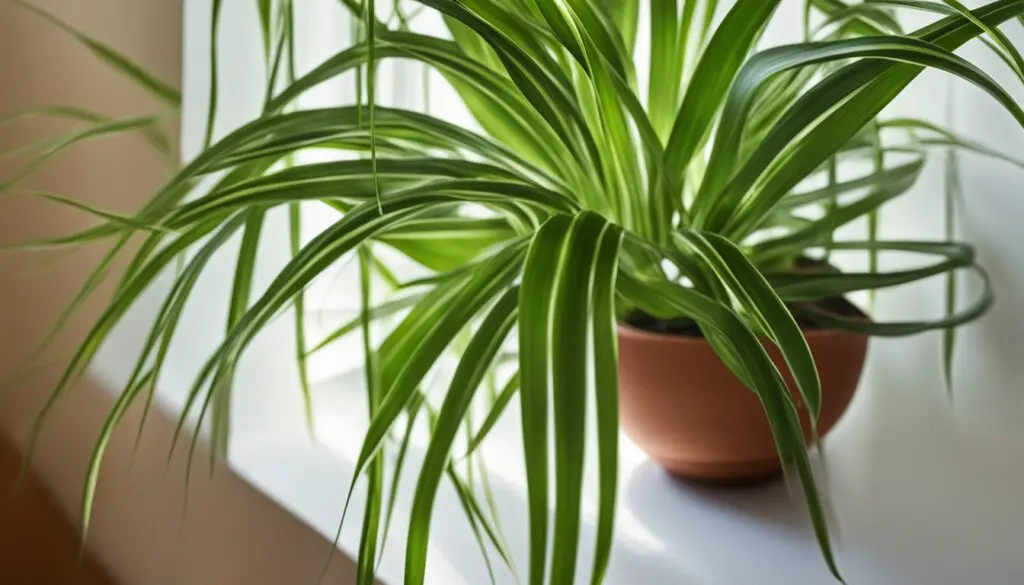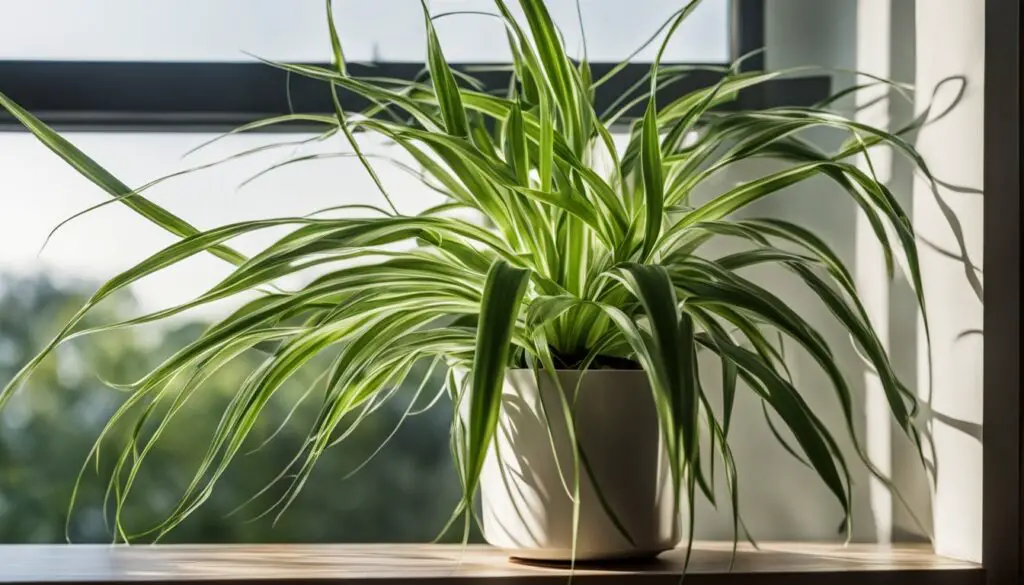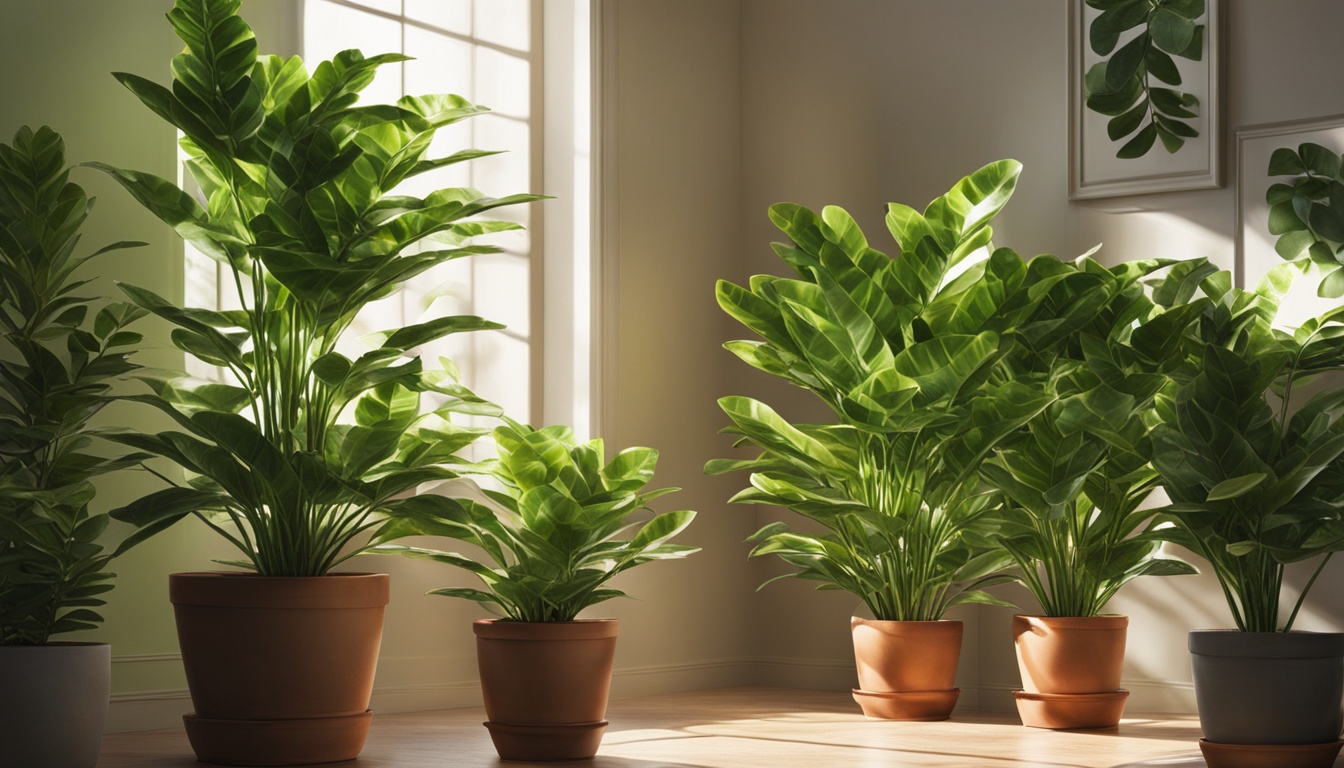The spider plant is a classic in the houseplant world. It’s a fast-growing plant that doesn’t need much attention.
It’s perfect for busy people or those who forget to water their plants. Plus, it’s safe around pets and kids.
This guide will help you grow and care for a spider plant. We’ll cover how to propagate, what light it needs, watering tips, and more.

Key Takeaways
- Spider plants are easy to grow and low-maintenance houseplants.
- They prefer bright, indirect light and regular watering during the growing season.
- Spider plants can be propagated easily by dividing the plantlets or “spiderettes”.
- They come in a variety of cultivars, including ‘Variegatum’, ‘Vittatum’, and ‘Bonnie’.
- Spider plants are non-toxic and can help purify indoor air by removing pollutants.
About Spider Plants: The Graceful and Hardy Houseplant
Botanical Classification and Origin
Spider plants are known scientifically as Chlorophytum comosum. They belong to the Asparagaceae family.
These houseplants are from the tropical and southern parts of Africa. They are part of the Chlorophytum genus, with Chlorophytum comosum being the main species grown indoors.
These plants are loved for their bright green leaves and elegant growth. The leaves can be solid green or have yellow or white patterns.
Spider plants can reach up to 50 centimeters tall indoors, depending on the light and planter size.
| Botanical Name | Chlorophytum comosum |
|---|---|
| Common Names | Spider plant, spider ivy, ribbon plant, airplane plant, ‘hen and chickens’ |
| Family | Asparagaceae |
| Native Range | Tropical and Southern Africa |
| Plant Height | Up to 50 cm (20 inches) |
| Leaf Color | Green, with or without variegation (yellow or white streaks) |
As spider plants grow, they produce “spiderettes” – small plantlets on long stems. These can be easily used to make new plants. This makes them great for expanding your indoor garden.
Spider plants are known for being easy to care for. They do well in medium to bright light and help purify the air. These traits make them a popular choice for indoor spaces.
Grow A Spider Plant and Care: The Essentials
Spider plants are easy to care for, making them perfect for beginners. To keep your spider plant happy, know the basics about soil, light, and water. Also, understand the needs for temperature and humidity.
Soil, Light, and Water Requirements
Spider plants like soil mixes that drain well and include perlite for air pockets. They need a bigger pot every other year to grow well. For light, they do best in bright, indirect sunlight, needing 4 to 6 hours of it.
Watering is simple: give it a light drink once a week. Water less in the cold months.
Temperature and Humidity Needs
The best indoor temperature for spider plants is 55 to 80 degrees Fahrenheit. They like average humidity and don’t need a humidifier. But, misting them regularly can keep the humidity right.
| Spider Plant Care Essentials | Recommended Conditions |
|---|---|
| Soil | Well-draining potting mix with perlite or similar aeration |
| Light | Bright, indirect sunlight for 4-6 hours per day |
| Watering | About once a week, less frequently in winter |
| Temperature | 55-80°F (13-27°C) |
| Humidity | Average humidity, with occasional misting |
Give your spider plant the right soil, light, water, temperature, and humidity. This will help it thrive and bring green beauty to your home.

Spider Plant Varieties and Propagation
I love exploring the many spider plant varieties. The classic Chlorophytum comosum ‘Variegatum’ stands out with its white or cream leaf edges and dark green stripes. Then there’s the elegant Chlorophytum comosum ‘Vittatum’, known for its white stripe and medium green edges.
Don’t forget the charming Chlorophytum comosum ‘Bonnie’, a compact type with curled leaves. It adds a unique touch to any room.
Propagating spider plants is easy and fun. I enjoy cutting off the baby spiderettes and planting them in damp soil or water. Watching these plants grow and produce new ones is rewarding. It’s perfect for both new and experienced plant lovers.
Spider plants are great for gardeners at any level. They’re easy to care for and can be easily multiplied. I suggest trying out different spider plant varieties and propagating them. It’s a great way to bring more greenery into your home.
FAQ
What are the common names for a spider plant?
The spider plant is also known as spider ivy, ribbon plant, airplane plant, and ‘hen and chickens’.
How big can a spider plant grow?
Spider plants can grow big in the wild. But, as a houseplant, they usually reach about 50cm tall. This size depends on the light and the pot size.
What are the light requirements for a spider plant?
Spider plants can handle various light levels. They do best in bright spots but avoid direct sunlight. They’re perfect for desks or shelves.
How do I water a spider plant?
Water your spider plant lightly every week or so. Water less in autumn and winter. Check the soil by sticking your finger in it. If it’s dry, it’s time to water.
How do I propagate a spider plant?
Propagating spider plants is easy. Just cut the spiderettes off the stem and plant them in damp compost.
Are there different varieties of spider plants?
Yes, there are several types of spider plants. Some include Chlorophytum comosum ‘Variegatum’, Chlorophytum comosum ‘Vittatum’, and Chlorophytum comosum ‘Bonnie’.
Are spider plants non-toxic?
Yes, spider plants are safe for pets and children. So, you don’t have to worry if you have them at home.



